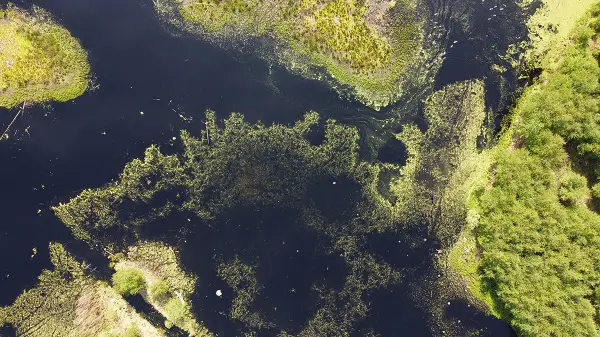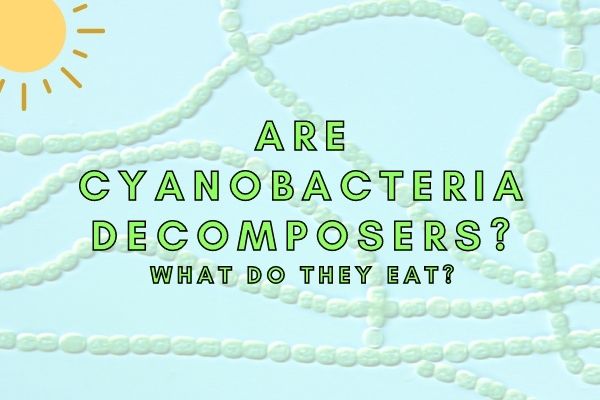Cyanobacteria, also known as blue-green algae, are a type of bacteria that live in fresh and salt water environments. Cyanobacteria are often mistaken for plants because of this, but they are actually bacteria not plants. They are producers, meaning they produce their own food using photosynthesis.
Because cyanobacteria can make their own energy through photosynthesis, they are not considered decomposers. Rather, they are producers that benefit directly from the minerals released by bacterial and fungal decomposers around them.
Cyanobacteria use the sun’s energy to convert carbon dioxide into oxygen and organic matter. This process is important for all life on Earth since it produces the oxygen we breathe and helps remove carbon dioxide from the atmosphere.
Where are Cyanobacteria Found?
Cyanobacteria are a group of bacteria with members living in all kinds of waters including saltwater and freshwater.
They grow best near the surface of still freshwaters, but they can also live on the surfaces of the ocean in rivers, swamp soils, and rocks in humid locations. In fact, lichen are a mix of cyanobacteria and fungi living in symbiosis!

Cyanobacteria are like algae in the sense that they need warmth, minerals and sunlight to grow. This is why they often grow best at the end of summer where it is warm and most nutrients are available.
Are Cyanobacteria Producers, Consumers or Decomposers?
Cyanobacteria are producers because they make their own food by photosynthesis. Cyanobacteria produce their own foods by the process of photosynthesis.
While primarily being producers, cyanobacteria can also sometimes be considered consumers as they do still have the same capability of eating and metabolizing simple sugars as most other bacteria and plants.
Why are Cyanobacteria not Decomposers?
Cyanobacteria are not decomposers because they do not have the enzymes needed to break down dead organic matter.
Decomposers have lots of enzymes that break the organic substances down to smaller and smaller compounds and those compounds can eventually be used by other organisms or disposed of themselves.
By contrast, cyanobacteria don’t have the enzymes to metabolize other organisms. Instead, being producers, they just build them up using sunlight as energy and CO2 as carbon building blocks.
Is a Cyanobacteria an Autotroph or a Heterotroph?
Cyanobacteria are autotrophs because they make their own food through photosynthesis – just like plants! Autotrophs make their own food from inorganic substances instead of eating other organisms.
What Nutrients are Required for Cyanobacteria to Grow?
The nutrients that are required by cyanobacteria to grow are carbon dioxide, sunlight (energy) and water (water is needed to transport nutrients and oxygen), as well as minerals that are needed for their metabolic enzymes to function properly.
That is, cyanobacteria need:
- Sunlight
- Carbon dioxide
- Minerals (Cobber, Zink, Iron, Nitrogen, Prosperous etc.)
- Water
This is the same components that plants need in their “diet” and is enough for them to grow and reproduce!
Where are Cyanobacteria in the Food Chain?
Cyanobacteria are producers because they make their own food by photosynthesis. Cyanobacteria are important for many reasons, but most importantly they are essential to the growth of other plants and animals.
The conversion of light to sugars (energy) by cyanobacteria is a vital part of the ecosystems and provides the raw material for the food chain. Without them there would be many different creatures that could not survive.
However, when most people think of cyanobacteria they think of the harmful ones: the blue-green algae that can make us sick in lakes and ponds, but it is important to remember that many species of cyanobacteria are good for us (in the grand scheme of things!) in our water environments!
Conclusion
In this post I have looked into the energy metabolism and habitat of cyanobacteria and how they are act as important producers for many different creatures.
Cyanobacteria were the first photo-synthesizing organism to evolve on earth, and it is still a dominant group of bacteria in many freshwater habitats today!
If you are interested in aquatic decomposers or why decomposers are important for ecosystems check my other posts.
You might also be interested in my recent post on another interesting organism that uses photosynthesis but can actually be considered an animal! Or actual animals that can do photosynthesis!




